Post-War Land Cover Changes and Fragmentation in Halgurd Sakran National Park (HSNP), Kurdistan Region of Iraq
Abstract
:1. Introduction
2. Materials and Methods
2.1. Study Area
2.2. Remote Sensing Data
2.3. Analyzing Changes for Fragmentation, Connectivity and Diversity
3. Results
3.1. Accuracy Assessment and the Performance Comparison of Two Algorithms
3.2. Land Use/Land Cover Changes Based on Random Forest Classification
3.2.1. Land Cover Class Distribution in the Upper and Lower Parts of Core Zone
3.2.2. Land Use/Land Cover Dynamics
4. Discussion
4.1. Landscape Fragmentation at Class Level
4.1.1. Bare Surface
4.1.2. Pasture
4.1.3. Cultivated Area
4.1.4. Forest Class
4.2. Drivers and Consequences of Changes on the Landscape
4.3. Random Forest Classification
5. Conclusions
Acknowledgments
Author Contributions
Conflicts of Interest
References
- Rahman, A.; Kumar, S.; Fazal, S.; Siddiqui, M.A. Assessment of land use/land cover change in the North-West District of Delhi using remote sensing and GIS techniques. J. Indian Soc. Remote Sens. 2012, 40, 689–697. [Google Scholar] [CrossRef]
- Natya, S.; Rehna, V. Land Cover Classification Schemes Using Remote Sensing Images: A Recent Survey. Br. J. Appl. Sci. Technol. 2016, 13, 1–11. [Google Scholar] [CrossRef]
- Usman, M.; Liedl, R.; Shahid, M.A.; Abbas, A. Land use/land cover classification and its change detection using multi-temporal MODIS NDVI data. J. Geogr. Sci. 2015, 25, 1479–1506. [Google Scholar] [CrossRef]
- Aspinall, R.J.; Hill, M.J. Land Use Change: Science, Policy and Management; CRC Press: Boca Raton, FL, USA, 2007. [Google Scholar]
- Van Dyke, F. The conservation of habitat and landscape. In Conservation Biology: Foundations, Concepts, Applications; Springer: Dordrecht, The Netherlands, 2008; pp. 279–311. [Google Scholar]
- Didham, R.K. Ecological consequences of habitat fragmentation. In eLS; John Wiley & Sons, Ltd.: Hoboken, NJ, USA, 2010. [Google Scholar]
- McGarigal, K.; Marks, B.J. Fragstats: Spatial Pattern Analysis Program for Quantifying Landscape Structure; General Technical Report PNW-GTR-351; U.S. Department of Agriculture, Forest Service, Pacific Northwest Research Station: Portland, OR, USA, 1995.
- Tizora, P.; Le Roux, A.; Mans, G.; Cooper, A. Land Use and Land Cover Change in the Western Cape Province: Quantification of Changes & Understanding of Driving Factors. 2016. Available online: http://hdl.handle.net/10204/8995 (accessed on 1st February).
- Krkoška Lorencová, E.; Harmáčková, Z.V.; Landová, L.; Pártl, A.; Vačkář, D. Assessing impact of land use and climate change on regulating ecosystem services in the Czech Republic. Ecosyst. Health Sustain. 2016, 2, e01210. [Google Scholar] [CrossRef]
- Berakhi, R.O. Implication of Human Activities on Land Use Land Cover Dynamics in Kagera Catchment, East Africa. Master’s Degree, Southern Illinois University Carbondale, Carbondale, IL, USA, December 2013. [Google Scholar]
- Gibson, G.R. War and Agriculture: Three Decades of Agricultural Land Use and Land Cover Change in Iraq. Doctoral Dissertation, University Libraries, Virginia Polytechnic Institute and State University, Blacksburg, VA, USA, 9 May 2012. [Google Scholar]
- Vogt, P. Quantifying landscape fragmentation. Simp. Brasil. Sensoriamento Remoto 2015, 17, 1239–1246. [Google Scholar]
- Midha, N.; Mathur, P. Assessment of forest fragmentation in the conservation priority Dudhwa landscape, India using FRAGSTATS computed class level metrics. J. Indian Soc. Remote Sens. 2010, 38, 487–500. [Google Scholar] [CrossRef]
- Vorovencii, I. Quantifying landscape pattern and assessing the land cover changes in Piatra Craiului National Park and Bucegi Natural Park, Romania, using satellite imagery and landscape metrics. Environ. Monit. Assess. 2015, 187, 692. [Google Scholar] [CrossRef] [PubMed]
- Girvetz, E.H.; Thorne, J.H.; Berry, A.M.; Jaeger, J.A. Integration of landscape fragmentation analysis into regional planning: A statewide multi-scale case study from California, USA. Landsc. Urban Plan. 2008, 86, 205–218. [Google Scholar] [CrossRef]
- Coppedge, B.R.; Engle, D.M.; Masters, R.E.; Gregory, M.S. Avian response to landscape change in fragmented southern Great Plains grasslands. Ecol. Appl. 2001, 11, 47–59. [Google Scholar] [CrossRef]
- Vannette, R.L.; Leopold, D.R.; Fukami, T. Forest area and connectivity influence root-associated fungal communities in a fragmented landscape. Ecology 2016, 97, 2374–2383. [Google Scholar] [CrossRef] [PubMed]
- Auffret, A.G.; Plue, J.; Cousins, S.A. The spatial and temporal components of functional connectivity in fragmented landscapes. Ambio 2015, 44, 51–59. [Google Scholar] [CrossRef] [PubMed]
- Mühlner, S.; Kormann, U.; Schmidt-Entling, M.; Herzog, F.; Bailey, D. Structural versus functional habitat connectivity measures to explain bird diversity in fragmented orchards. J. Landsc. Ecol. 2010, 3, 52–64. [Google Scholar] [CrossRef]
- Forman, R.T. Land Mosaics: The Ecology of Landscapes and Regions (1995); Cambridge University Press: Cambridge, UK, 1995. [Google Scholar]
- Lovett, G.M.; Jones, C.G.; Turner, M.G.; Weathers, K.C. Conceptual Frameworks: Plan for a Half-Built House. In Ecosystem Function in Heterogeneous Landscapes; Springer: New York, NY, USA, 2005; pp. 463–470. [Google Scholar]
- Southworth, J.; Nagendra, H.; Tucker, C. Fragmentation of a landscape: Incorporating landscape metrics into satellite analyses of land-cover change. Landsc. Res. 2002, 27, 253–269. [Google Scholar] [CrossRef]
- Parsa, V.A.; Yavari, A.; Nejadi, A. Spatio-temporal analysis of land use/land cover pattern changes in Arasbaran Biosphere Reserve: Iran. Model. Earth Syst. Environ. 2016, 2, 178. [Google Scholar] [CrossRef]
- Linh, N.; Erasmi, S.; Kappas, M. Quantifying land use/cover change and landscape fragmentation in Danang City, Vietnam: 1979–2009. Int. Arch. Photogramm. Remote Sens. Spat. Inf. Sci. 2012, 39-B8, 501–506. [Google Scholar] [CrossRef]
- Lu, D.; Hetrick, S.; Moran, E. Impervious surface mapping with Quickbird imagery. Int. J. Remote Sens. 2011, 32, 2519–2533. [Google Scholar] [CrossRef] [PubMed]
- Foody, G.M. Status of land cover classification accuracy assessment. Remote Sens. Environ. 2002, 80, 185–201. [Google Scholar] [CrossRef]
- Lillesand, T.; Kiefer, R.W.; Chipman, J. Remote Sensing and Image Interpretation; John Wiley & Sons: Hoboken, NJ, USA, 2014. [Google Scholar]
- Li, M.; Zang, S.; Zhang, B.; Li, S.; Wu, C. A review of remote sensing image classification techniques: The role of spatio-contextual information. Eur. J. Remote Sens. 2014, 47, 389–411. [Google Scholar] [CrossRef]
- Syed, S.; Dare, P.; Jones, S. Automatic classification of land cover features with high resolution imagery and lidar data: An object-oriented approach. In Proceedings of the National Biennial Conference of the Spatial Sciences Institute, Melbourne, Australia, 12–16 September 2005. [Google Scholar]
- Burai, P.; Deák, B.; Valkó, O.; Tomor, T. Classification of herbaceous vegetation using airborne hyperspectral imagery. Remote Sens. 2015, 7, 2046–2066. [Google Scholar] [CrossRef]
- Qian, J.; Zhou, Q.; Hou, Q. Comparison of pixel-based and object-oriented classification methods for extracting built-up areas in arid zone. In Proceedings of the ISPRS Workshop on Updating Geo-spatial Databases with Imagery & The 5th ISPRS Workshop on Dynamic and Multi-dimensional GIS, Urumchi, China, 28–29 August 2007; pp. 163–171. [Google Scholar]
- Horning, N. Random Forests: An algorithm for image classification and generation of continuous fields data sets. In Proceedings of the International Conference on Geoinformatics for Spatial Infrastructure Development in Earth and Allied Sciences, Hanoi, Vietnam, 9–11 December 2010. [Google Scholar]
- Breiman, L. Random forests. Mach. Learn. 2001, 45, 5–32. [Google Scholar] [CrossRef]
- Liaw, A.; Wiener, M. Classification and regression by randomForest. R News 2002, 2, 18–22. [Google Scholar]
- Balzter, H.; Cole, B.; Thiel, C.; Schmullius, C. Mapping CORINE land cover from Sentinel-1A SAR and SRTM digital elevation model data using Random Forests. Remote Sens. 2015, 7, 14876–14898. [Google Scholar] [CrossRef]
- Hamad, R.; Balzter, H.; Kolo, K. Multi-Criteria Assessment of Land Cover Dynamic Changes in Halgurd Sakran National Park (HSNP), Kurdistan Region of Iraq, Using Remote Sensing and GIS. Land 2017, 6, 18. [Google Scholar] [CrossRef]
- Williams, K.J.; Schirmer, J. Understanding the relationship between social change and its impacts: The experience of rural land use change in south-eastern Australia. J. Rural Stud. 2012, 28, 538–548. [Google Scholar] [CrossRef]
- Schirmer, J. Socio-Economic Impacts of Land Use Change to Plantation Forestry: A Review of Current Knowledge and Case Studies of Australian Experience. In Proceedings of the 2006 IUFRO Forest Plantations Meeting, Charleston, SC, USA, 10–13 October 2006. [Google Scholar]
- Long, H.; Tang, G.; Li, X.; Heilig, G.K. Socio-economic driving forces of land-use change in Kunshan, the Yangtze River Delta economic area of China. J. Environ. Manag. 2007, 83, 351–364. [Google Scholar] [CrossRef] [PubMed]
- Figueiredo, J.; Pereira, H.M. Regime shifts in a socio-ecological model of farmland abandonment. Landsc. Ecol. 2011, 26, 737–749. [Google Scholar] [CrossRef]
- Brown, D.; Polsky, C.; Bolstad, P.V.; Brody, S.D.; Hulse, D.; Kroh, R.; Loveland, T.; Thomson, A.M. Land Use and Land Cover Change; Pacific Northwest National Laboratory (PNNL): Richland, WA, USA, 2014. [Google Scholar]
- Saleh, S.A. Temporal Change Detection of AL-Hammar Marsh—IRAQ Using Remote Sensing Techniques. Glob. J. Hum. Soc. Sci. Res. 2012, 12, 7–14. [Google Scholar]
- Nagendra, H.; Lucas, R.; Honrado, J.P.; Jongman, R.H.; Tarantino, C.; Adamo, M.; Mairota, P. Remote sensing for conservation monitoring: Assessing protected areas, habitat extent, habitat condition, species diversity, and threats. Ecol. Indic. 2013, 33, 45–59. [Google Scholar] [CrossRef]
- Stoms, D.M.; Estes, J. A remote sensing research agenda for mapping and monitoring biodiversity. Int. J. Remote Sens. 1993, 14, 1839–1860. [Google Scholar] [CrossRef]
- Dewan, A.M.; Yamaguchi, Y. Land use and land cover change in Greater Dhaka, Bangladesh: Using remote sensing to promote sustainable urbanization. Appl. Geogr. 2009, 29, 390–401. [Google Scholar] [CrossRef]
- El-Kawy, O.A.; Rød, J.; Ismail, H.; Suliman, A. Land use and land cover change detection in the western Nile delta of Egypt using remote sensing data. Appl. Geogr. 2011, 31, 483–494. [Google Scholar] [CrossRef]
- Prakasam, C. Land use and land cover change detection through remote sensing approach: A case study of Kodaikanal taluk, Tamil nadu. Int. J. Geomat. Geosci. 2010, 1, 150. [Google Scholar]
- Leh, M.; Bajwa, S.; Chaubey, I. Impact of land use change on erosion risk: An integrated remote sensing, geographic information system and modeling methodology. Land Degrad. Dev. 2013, 24, 409–421. [Google Scholar] [CrossRef]
- Chuvieco, E.; Congalton, R.G. Application of remote sensing and geographic information systems to forest fire hazard mapping. Remote Sens. Environ. 1989, 29, 147–159. [Google Scholar] [CrossRef]
- Boyd, D.; Danson, F. Satellite remote sensing of forest resources: Three decades of research development. Prog. Phys. Geogr. 2005, 29, 1–26. [Google Scholar] [CrossRef]
- Kayiranga, A.; Kurban, A.; Ndayisaba, F.; Nahayo, L.; Karamage, F.; Ablekim, A.; Li, H.; Ilniyaz, O. Monitoring forest cover change and fragmentation using remote sensing and landscape metrics in Nyungwe-Kibira park. J. Geosci. Environ. Prot. 2016, 4, 13. [Google Scholar] [CrossRef]
- Robinson, L. Masters of Chaos: The Secret History of the Special Forces; PublicAffairs: New York, NY, USA, 2005. [Google Scholar]
- Eklund, L.; Persson, A.; Pilesjö, P. Cropland changes in times of conflict, reconstruction, and economic development in Iraqi Kurdistan. Ambio 2016, 45, 78–88. [Google Scholar] [CrossRef] [PubMed]
- KRSO. Ministry of Planning 2016. Kurdistan Regional Statistics Office-KRSO. Available online: http//www.mop.gov.krd (accessed on 25 January 2017).
- Eiumnoh, A.; Shrestha, R.P. Application of DEM data to Landsat image classification: Evaluation in a tropical wet-dry landscape of Thailand. Photogramm. Eng. Remote Sens. 2000, 66, 297–304. [Google Scholar]
- Ok, A.O.; Akar, O.; Gungor, O. Evaluation of random forest method for agricultural crop classification. Eur. J. Remote Sens. 2012, 45, 421–432. [Google Scholar] [CrossRef]
- Thakkar, A.K.; Desai, V.R.; Patel, A.; Potdar, M.B. Post-classification corrections in improving the classification of Land Use/Land Cover of arid region using RS and GIS: The case of Arjuni watershed, Gujarat, India. Egypt. J. Remote Sens. Space Sci. 2017, 20, 79–89. [Google Scholar] [CrossRef]
- Donges, N. SAP Machine Learning Foundation Working Student. Available online: https://towardsdatascience.com/@n.donges (accessed on 25 Feb 2018).
- Guan, H.; Yu, J.; Li, J.; Luo, L. Random forests-based feature selection for land-use classification using lidar data and orthoimagery. Int. Arch. Photogramm. Remote Sens. Spat. Inf. Sci. 2012, 39-B7, 203–208. [Google Scholar] [CrossRef]
- Kulkarni, A.D.; Lowe, B. Random forest algorithm for land cover classification. Pattern Recognit. Lett. 2016, 27, 294–300. [Google Scholar]
- Reynolds, J.; Wesson, K.; Desbiez, A.L.; Ochoa-Quintero, J.M.; Leimgruber, P. Using remote sensing and Random Forest to assess the conservation status of critical Cerrado Habitats in Mato Grosso do Sul, Brazil. Land 2016, 5, 12. [Google Scholar] [CrossRef]
- McGarigal, K.; Cushman, S.A.; Neel, M.C.; Ene, E. FRAGSTATS: Spatial Pattern Analysis Program for Categorical Maps. 2002. Available online: http://www.umass.edu/landeco/research/fragstats/fragstats.html (accessed on 25 January 2018).
- Nkonya, E.; Mirzabaev, A.; Von Braun, J. Economics of Land Degradation and Improvement: A Global Assessment for Sustainable Development; Springer: Cham, Switzerland, 2016. [Google Scholar]
- Speir, R.A. Managing Runoff and Erosion on Croplands and Pastures. 2009. Available online: http://aware.uga.edu/wp-content/2009/07/Erosion-and-Runoff-Update.pdf (accessed on 25 January 2018).
- Munguía-Rosas, M.A.; Montiel, S. Patch size and isolation predict plant species density in a naturally fragmented forest. PLoS ONE 2014, 9, e111742. [Google Scholar] [CrossRef] [PubMed]
- Harrison, S.; Bruna, E. Habitat fragmentation and large-scale conservation: What do we know for sure? Ecography 1999, 22, 225–232. [Google Scholar] [CrossRef]
- Kadioğullari, A.I.; Başkent, E.Z. Spatial and temporal dynamics of land use pattern in Eastern Turkey: A case study in Gümüşhane. Environ. Monit. Assess. 2008, 138, 289–303. [Google Scholar] [CrossRef] [PubMed]
- Kamusoko, C.; Aniya, M. Land use/cover change and landscape fragmentation analysis in the Bindura District, Zimbabwe. Land Degrad. Dev. 2007, 18, 221–233. [Google Scholar] [CrossRef]
- Eklund, L.; Seaquist, J. Meteorological, agricultural and socioeconomic drought in the Duhok Governorate, Iraqi Kurdistan. Nat. Hazards 2015, 76, 421–441. [Google Scholar] [CrossRef]
- Lortz, M.G. Willing to Face Death: A history of Kurdish Military Forces-the Peshmerga-from the Ottoman Empire to Present-Day Iraq. Doctoral Dissertation, Florida State University, Tallahassee, FL, USA, 2005. [Google Scholar]

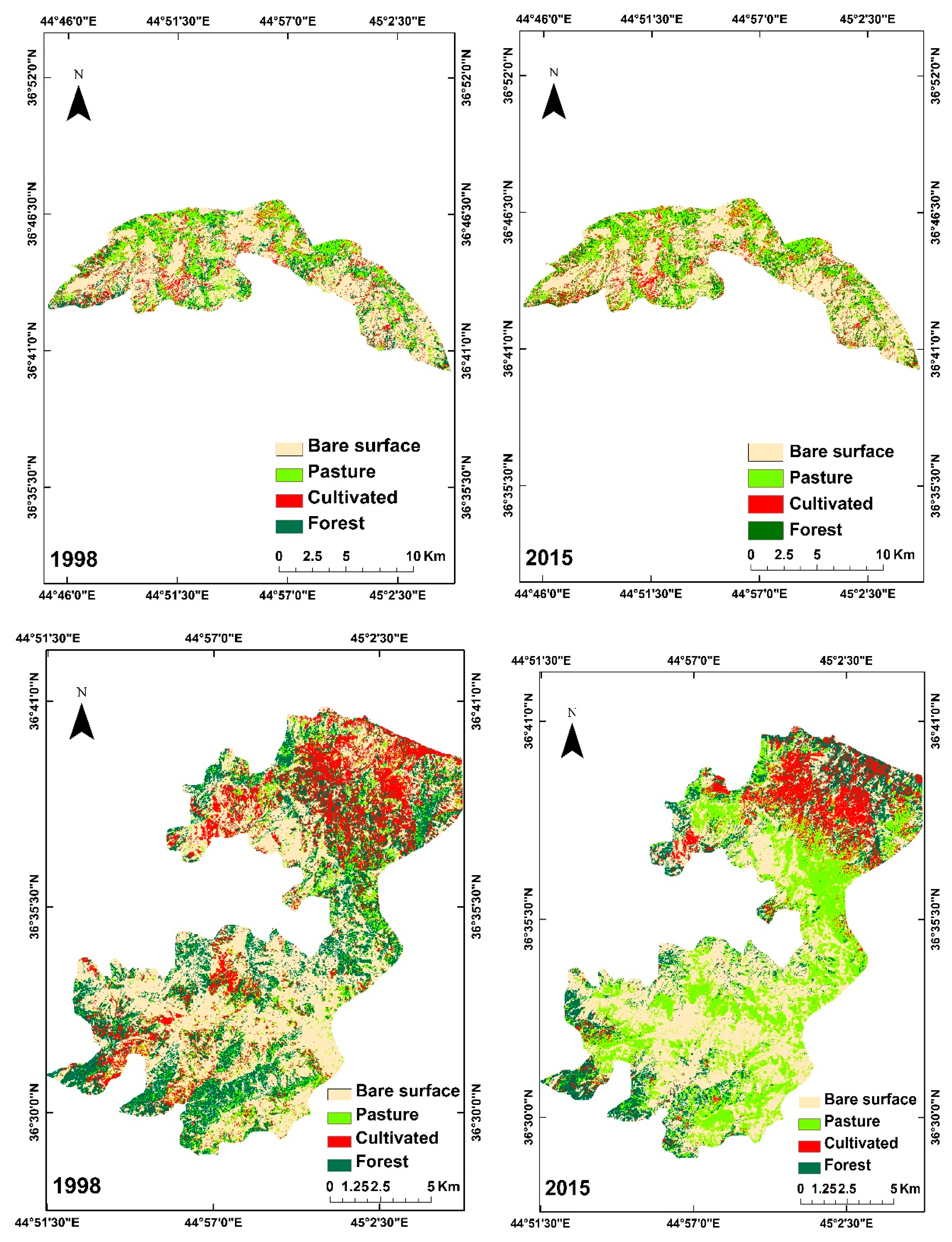
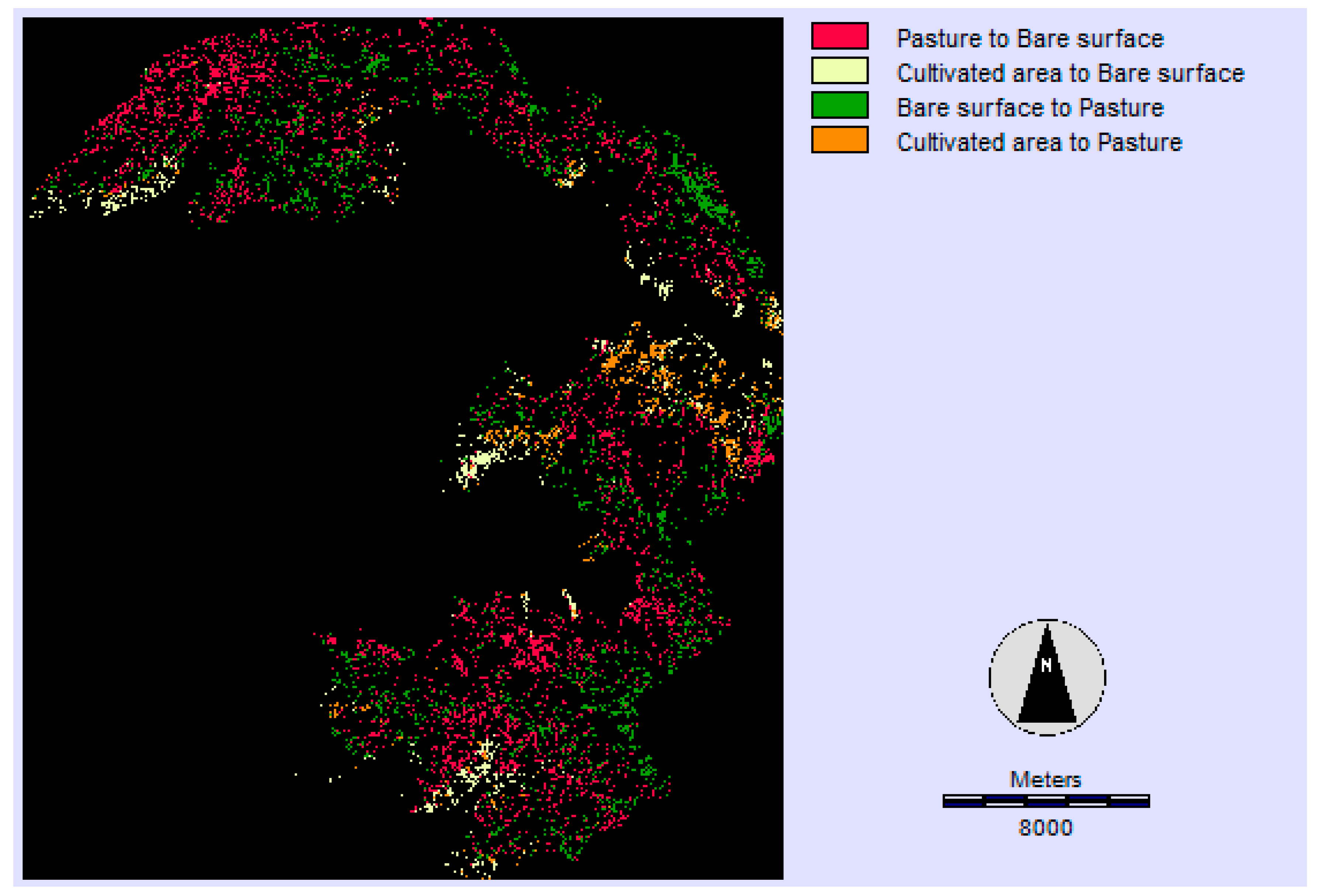
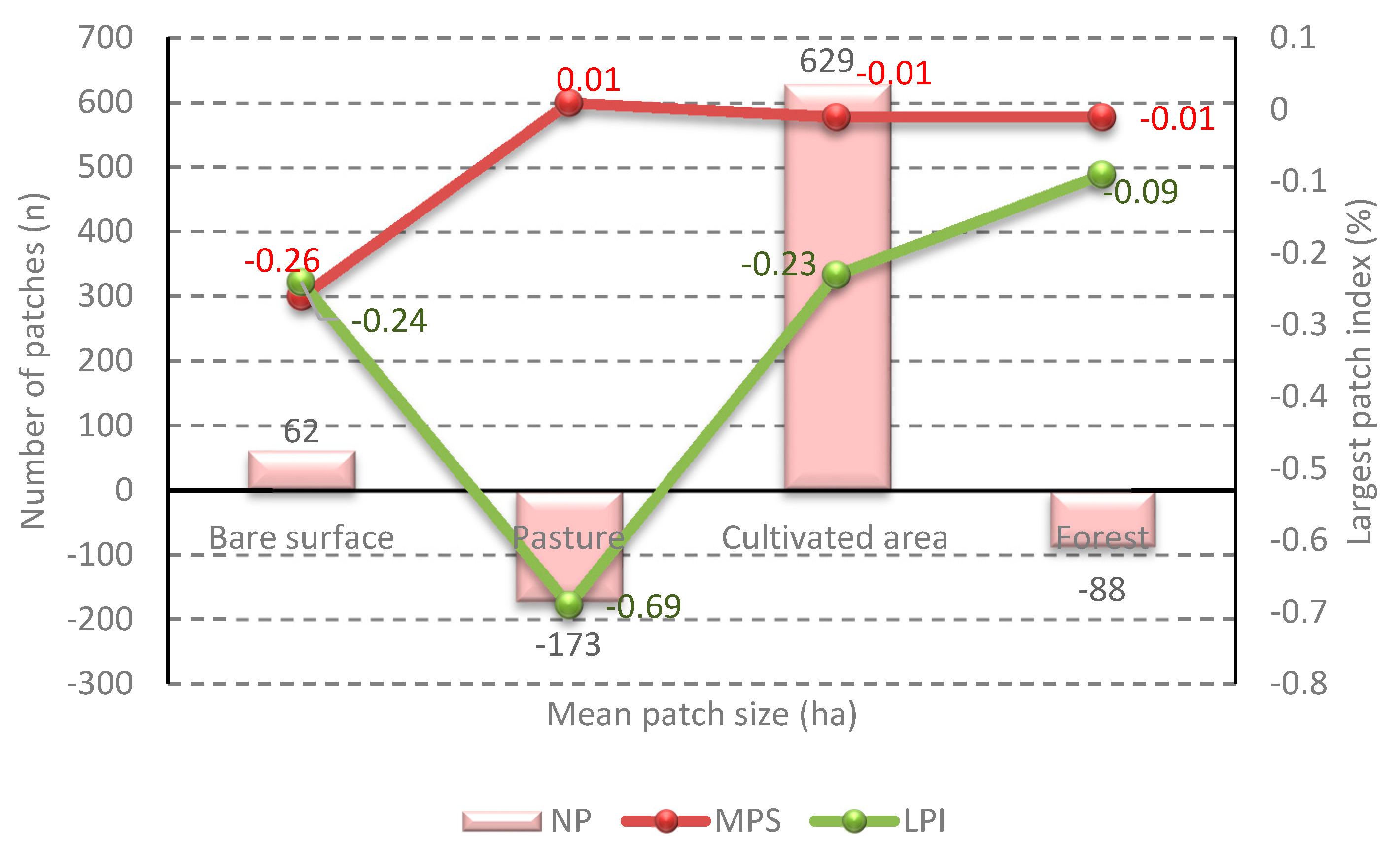
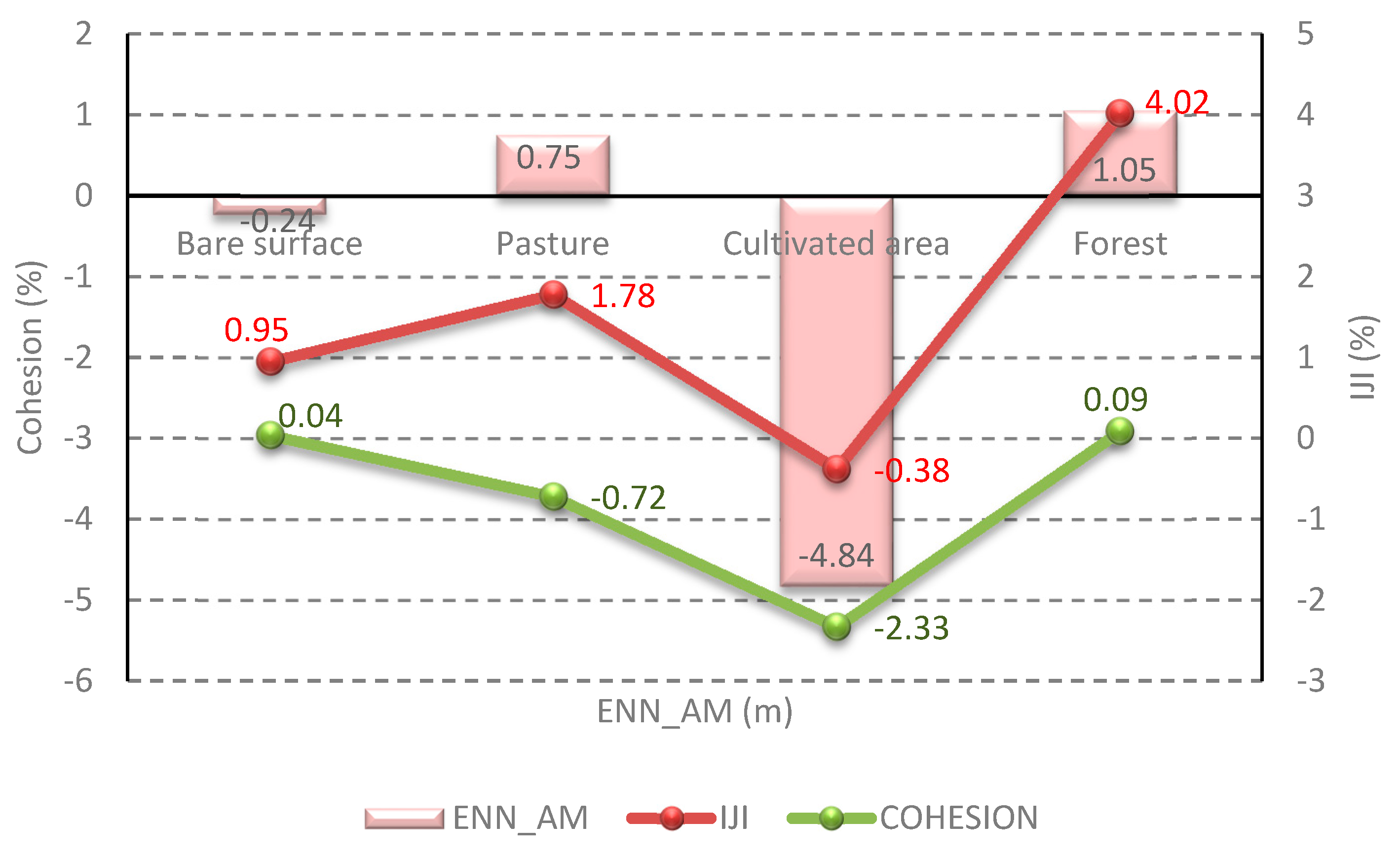

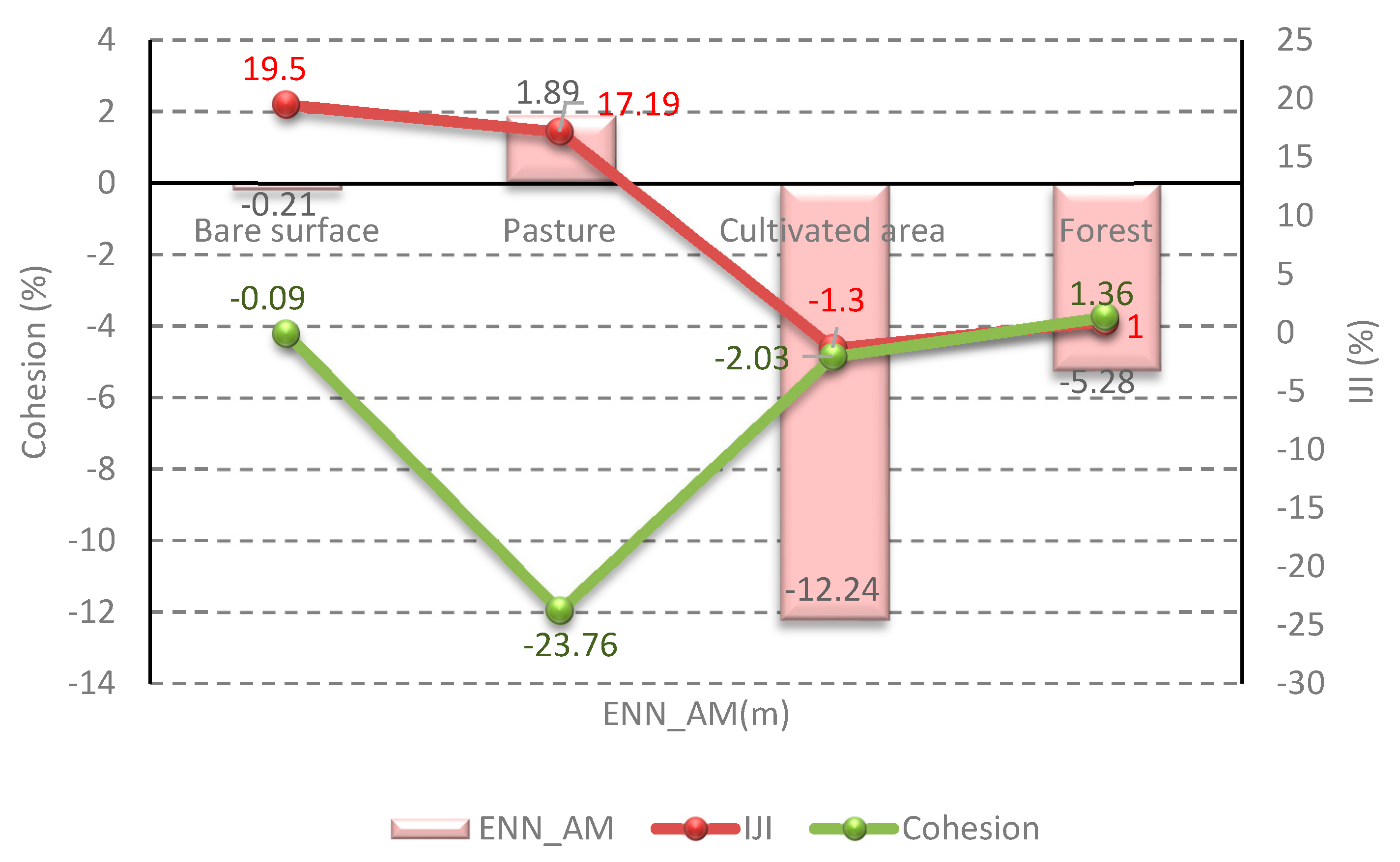
| Rural Rate | 2010 | 2011 | 2012 | 2013 | 2014 | 2015 |
|---|---|---|---|---|---|---|
| Choman Villages | 12,008 | 12,348 | 12,689 | 13,037 | 13,389 | 13,746 |
| Satellite Sensor | Path/Row | Acquisition Date | Resolution | Band Nos. |
|---|---|---|---|---|
| Landsat 7 ETM+ | 169/035 | 13 September 1998 | 30 m | 1, 2, 3, 4, 5, 7 |
| Landsat 8 LDCM | 169/035 | 24 August 2015 | 30 m | 1, 2, 3, 4, 5, 7, 8, 9 |
| Metrics * | Units | Description |
|---|---|---|
| Percentage of land (PLAND) | % | Amount of the landscape occupied by certain LULC class [7] |
| Number of patches (NP) | n | Number of patches per class [7] |
| Largest patch index (LPI) | % | Percentage of landscape accounted for by largest patch [20] |
| Mean patch size (MPS) | ha | Mean area of patches of the same LULC class [62] |
| Euclidian Nearest Neighborhood | m | The measure of patch context to quantify patch isolation [62] |
| Distance (ENN_AM) | ||
| Interspersion and juxtaposition (IJI) | % | Degree of intermixing of class patch types [7] |
| COHESION (Cohesion) | % | The physical connectedness of the corresponding class patch [62] |
| Land-Cover Class | MLC | RF | ||
|---|---|---|---|---|
| 1998-Upper Part | 2015-Upper Part | 1998-Upper Part | 2015-Upper Part | |
| Overall accuracy (%) | 66.20 | 81 | 98 | 98 |
| κ | 0.55 | 0.74 | 0.97 | 0.97 |
| 1998-Lower Part | 2015-Lower Part | 1998-Lower Part | 2015-Lower Part | |
| Overall accuracy (%) | 57 | 84 | 99 | 99 |
| κ | 0.67 | 0.79 | 0.98 | 0.99 |
| LULC Class | Up-1998 | Up-2015 | Lp-1998 | Lp-2015 |
|---|---|---|---|---|
| Bare surface | 51.84 | 51.49 | 44.89 | 43.80 |
| Pasture | 22.43 | 23.47 | 12.21 | 30.76 |
| Cultivated area | 10.19 | 8.80 | 15.95 | 9.80 |
| Forest | 15.52 | 16.14 | 26.93 | 15.76 |
© 2018 by the authors. Licensee MDPI, Basel, Switzerland. This article is an open access article distributed under the terms and conditions of the Creative Commons Attribution (CC BY) license (http://creativecommons.org/licenses/by/4.0/).
Share and Cite
Hamad, R.; Kolo, K.; Balzter, H. Post-War Land Cover Changes and Fragmentation in Halgurd Sakran National Park (HSNP), Kurdistan Region of Iraq. Land 2018, 7, 38. https://doi.org/10.3390/land7010038
Hamad R, Kolo K, Balzter H. Post-War Land Cover Changes and Fragmentation in Halgurd Sakran National Park (HSNP), Kurdistan Region of Iraq. Land. 2018; 7(1):38. https://doi.org/10.3390/land7010038
Chicago/Turabian StyleHamad, Rahel, Kamal Kolo, and Heiko Balzter. 2018. "Post-War Land Cover Changes and Fragmentation in Halgurd Sakran National Park (HSNP), Kurdistan Region of Iraq" Land 7, no. 1: 38. https://doi.org/10.3390/land7010038






